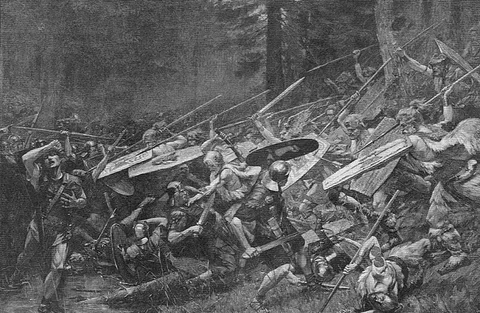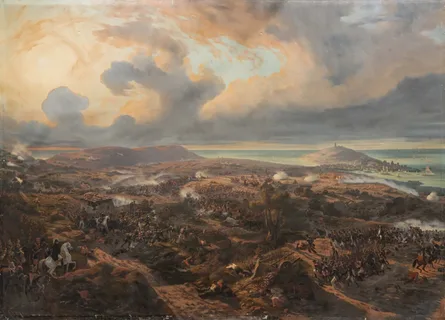The early years of Islam in Medina were marked by a series of significant military expeditions. Among these was the Battle of Dhu Amr (also known as the Raid on Dhu Amarr or the Raid on Ghatafan), which took place in the third year after the Hijrah (3 AH), corresponding to approximately March 625 CE. This event showcased the Muslim community’s evolving defensive and diplomatic strategies under the leadership of Prophet Muhammad and holds an important place within early Islamic military history.
The Battle of Dhu Amr

After the successful but costly Battle of Badr (2 AH), tension between the emerging Muslim state in Medina and the surrounding tribes increased. Some tribes, feeling threatened by the Muslims’ growing influence, considered launching raids against Medina. Intelligence about these threats reached Medina, prompting the Prophet to take precautionary measures. One such counteraction was the expedition to Dhu Amr, following the Invasion of Sawiq.
The Tribes Involved
-
Banu Muharib
-
Banu Thalabah
-
Both were influential in the Najd region and associated with the larger Ghatafan tribal confederation, known for their frequent hostilities toward Medina and alliances with other anti-Muslim elements.
Read more: The battle of Al-Asherah (2 Hijri).
The Motivation for the Expedition
A month after the Invasion of Sawiq, news reached the Prophet that a coalition of Ghatafan tribes had gathered at Dhu Amr — a strategic location in Najd — planning an attack on Medina. Muhammad’s strategy was often preemptive: rather than remain under constant threat of surprise attacks, he chose to neutralize potential threats before they could mobilize.
The Expedition Commences
Prophet Muhammad personally led a contingent of approximately 450 men — at the time, this was the largest force raised by the Muslims for any single expedition prior to the famous Battle of Uhud. Before leaving, he appointed Uthman ibn Affan as the governor in Medina during his absence.
Strategic Aims
-
To disperse enemy forces before they could launch raids on Medina.
-
To assert Muslim strength and dissuade alliances against Medina.
-
To maintain the security and morale of the nascent Muslim community.
Read about: The battle of Al-Saweeq (2 Hijri).
The March to Dhu Amr
The journey into the region of Najd was arduous, crossing stretches of desert and relying on limited resources. The Muslim force moved quickly and with determination.
Hearing of the Muslims’ march, the Ghatafan coalition, rather than choosing to confront directly, dispersed and sought refuge in the hills. Their intention to attack Medina was thwarted by the swift and unexpected arrival of the Muslim force.
Results of the Expedition
-
No major battle took place: The Ghatafan and their allies, upon learning about the Muslim army’s approach, opted for a tactical retreat.
-
Prisoner captured: The Muslims captured a single man, who, after interacting with the Muslim community, chose to embrace Islam and later guided the Muslims.
-
Demonstration of strength and resolve: The expedition sent a strong message to hostile tribes, discouraging raids on Medina and showing the Muslims’ ability to carry out proactive security operations.
Aftermath and Significance
The fact that the anticipated battle did not take place reflected a shift in the reputation and deterrent power of the Muslims. The community was no longer seen as passive or easily targeted. Instead, Muhammad’s leadership in confronting threats directly raised the status of the Muslim force among the tribes of the Arabian Peninsula.
Precedent for Preemptive Defense
This expedition established a precedent for preemptive defense in Islamic strategy, showcasing that securing the community could sometimes require proactive military actions even when not directly attacked.
Influence on Future Expeditions
Though not as well-known as the battles of Badr or Uhud, the expedition to Dhu Amr demonstrated the value of intelligence gathering and swift mobilization — lessons that would echo in later campaigns and negotiations.
Connection to Broader Political Events
The Dhu Amr expedition fit within a period of continuous tension and sporadic conflict between the Muslims of Medina and other regional powers. These years saw several expeditions, often concluded without combat but serving vital diplomatic or protective ends.
Recommend: The battle of Bani Saleem (2 Hijri).
Broader Context: The Early Third Year After Hijra
The year 3 AH featured several other important events, including military skirmishes, alliances, and preparation for the coming Battle of Uhud. Mutual suspicions between the Muslim community and neighboring tribes led to several such expeditions. The Prophet’s leadership was characterized by readiness, adaptability, and willingness to employ both diplomacy and force as situations demanded.
Lessons from the Battle of Dhu Amr
-
Importance of intelligence: Reliable information about enemy movements enabled the Muslims to avoid surprise attacks and take control of situations.
-
Moral and psychological warfare: The swift dispersal of the enemy without combat enhanced the Muslims’ aura of strength and unpredictability.
-
Role of compassion: The humane treatment and ultimate conversion of the captured prisoner promoted the message and values of Islam.
-
Adaptability in military tactics: Moving quickly and preemptively set a new standard for engagement.
FAQs
What was the Battle of Dhu Amr and when did it occur?
The Battle of Dhu Amr, also called the Raid on Dhu Amarr or the Raid on Ghatafan, took place in the third year after Hijrah (3 AH), corresponding to March 625 CE. It was a preemptive expedition by Prophet Muhammad and his companions to thwart a planned raid against Medina by the Ghatafan tribes.
Who were the main tribes involved in planning the attack on Medina?
The Banu Muharib and Banu Thalabah, both part of the larger Ghatafan confederation, were the tribes reportedly gathering forces at Dhu Amr with intentions to attack Medina.
Was there any actual fighting during this expedition?
No major fighting occurred. The enemy, upon hearing of the approaching Muslim force, scattered and took sanctuary in the hills, thus avoiding direct confrontation with the Muslims.
What was the outcome of the expedition?
The expedition ended successfully for the Muslims: the threat to Medina was averted, a potential attacker was captured and converted to Islam, and no losses were incurred by the Muslims. The event enhanced the Muslims' reputation and deterred further immediate threats from hostile tribes.
Why is the Battle of Dhu Amr important in Islamic history?
Despite the absence of combat, the expedition is significant for showcasing the Prophet’s proactive defense strategies, the effective use of intelligence, and the prioritization of community security. It demonstrated the Muslims' growing capability to deter aggression by assertive and timely action.
Conclusion
The Battle of Dhu Amr (3 AH) was less a classic military engagement and more a demonstration of strategic leadership and community defense. The event’s lack of actual combat did not diminish its importance; instead, it underscores how early Islamic history was shaped as much by maneuver and deterrence as by battlefield victories. Prophet Muhammad’s decision to act on intelligence and confront threats directly proved transformative in raising the profile of Medina as a secure, assertive, and respected state in Arabia. The expedition emphasized the values of preparedness, deterrent strength, and humane conduct, serving as a template for future engagements.

